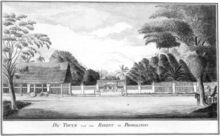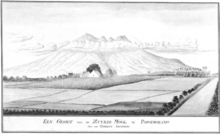Han Kik Ko
Han Kik Ko, Majoor der Chinezen, Regent van Probolinggo (1766 – 1813), also known as Han Tik Ko in European sources, was a Peranakan Chinese magnate, government official and landlord in East Java.[1][2][3][4][5] He is remembered today as a pioneer of the sugar industry in East Java, and for his acquisition and despotic rule of the district of Probolinggo.[1][3][4]
Majoor Han Kik Ko | |
|---|---|
| Kapitein der Chinezen of Pasuruan | |
| In office 1808–1810 | |
| Constituency | Pasuruan, East Java |
| Regent of Probolinggo | |
| In office 1810 – 1813 (died in office) | |
| Preceded by | Unknown |
| Succeeded by | Raden Soetik |
| Constituency | Probolinggo, East Java |
| Personal details | |
| Born | 1766 Surabaya, East Java |
| Died | 1813 Probolinggo, East Java |
| Relations | Han Siong Kong (grandfather) Han Chan Piet, Majoor der Chinezen (brother) |
| Children | Han Tjan Goan, Kapitein der Chinezen |
| Father | Han Bwee Kong, Kapitein der Chinezen |
| Residence | Pasuruan & Probolinggo, East Java |
| Occupation | Majoor der Chinezen, priyayi, landlord |
Family background
Han Kik Ko Sia was born in Surabaya in 1767, the fifth of twelve sons, to Han Bwee Kong (1727–1778), and was as such a grandson of the Chinese migrant Han Siong Kong (1673–1743), founder of the powerful Han family of Lasem.[1] His father, Han Bwee Kong, held the civil government post of Kapitein der Chinezen, which gave him legal and political authority over the Chinese community of Surabaya.[2][6] As the son of a Chinese officer, Han Kik Ko bore the hereditary title 'Sia'.[7]
Other prominent members of his family include his elder brother and fellow landlord, Han Chan Piet, Majoor der Chinezen (1759–1827); his uncle, the Muslim convert and magnate, Ngabehi Soero Pernollo (1720–1776); and his cousins, the Javanese noblemen and bureaucrats Adipati Soero Adinegoro (1752–1833) and Raden Soero Adiwikromo.[2][3][8] His family played an important role in the consolidation of Dutch rule in East Java in the mid-eighteenth century, as well as the subsequent administration and economic development of the region.[1][2][3][8]
Landlord and official


By the early nineteenth century, Han Kik Ko was already a significant landlord in East Java.[1][2] He owned land outside Surabaya, and rented a country estate in Kraton, in the Residency of Pasuruan, consisting of 12 villages and 2,538 souls.[1][2] At the same time, he also received his first government appointment as Kapitein der Chinezen of Pasuruan.[1][2]
The Kapitein played an important role as pioneer of the sugar industry in East Java.[1][2] The region's oldest sugar mill, dating to 1799, was established by the Kapitein on his estate in Pasuruan.[1][2]
In 1810, after the purchase of Besuki and Panarukan by Majoor Han Chan Piet, the Kapitein decided to follow his elder brother's example by buying the district of Probolinggo.[1][3][4][5] He agreed to pay the extraordinary sum of one million Spanish dollars in a series of instalments to the government of Herman Willem Daendels, Governor-General of the Dutch East Indies during the Interregnum (1806 – 1815).[9]
Daendels subsequently promoted the Kapitein to the dignity of Majoor der Chinezen, as well as Regent of Probolinggo with the Javanese noble title of Tumanggung.[1][3][5] The new Majoor-Regent had direct authority over 150,000 souls in contrast to his brother, Majoor Han Chan Piet, who ruled the districts of Besuki and Panarukan through allied members of the traditional Javanese bureaucracy, including Muslim members of the Han family of Lasem.[9]
Majoor Han Kik Ko's rule gave rise to favourable development in the district: new methods of irrigation were implemented, rice cultivation increased, and new crops were introduced.[1][2] The Majoor-Regent also encouraged Madurese immigration into his territory in order to increase its population.[1][2]
He was accused, however, of despotism in his rule of Probolinggo.[1][2] Fifty percent of all crops grown in the district was taken as tribute.[4] The rest was purchased compulsorily by the Majoor-Regent for a dismal sum.[4] There were additional taxes on many other things, ranging from on living people to funerals, and on to buffaloes.[4]
On May 18, 1813, an uprising broke out – later dubbed Kepruk Cina (‘Attack on the Chinese’).[3][4] At the time, Majoor Han Kik Ko was entertaining visiting British dignitaries, all of whom were caught unaware.[3][4] The Majoor-Regent and some of his guests were killed by the rebels.[3][4]
Aftermath
The British government of Sir Stamford Raffles, who had succeeded Daendels as Governor-General, took this opportunity to repurchase the district from the Majoor-Regent's heirs.[3][4] In return, three of the latter's sons were given a lifelong usufruct of the district.[1][2]
The family connection with both Pasuruan and Probolinggo was maintained.[1][2] Four of the Majoor-Regent's sons were active in the sugar industry in Pasuruan, and left descendants who maintained their prominence in the region.[1] Han Tjan Gwan, second son of the Majoor-Regent, moved back to Probolinggo and was appointed its Kapitein der Chinezen from 1847 until 1860.[1]
Descendants of the Majoor's Javanese uncle, Ngabehi Soero Pernollo, also maintained government positions in Probolinggo.[1][8] The latter's grandson, Raden Soetik (from 1816 until 1818), and great-grandson, Raden Karaman (in 1856), were both appointed Regents of Probolinggo in succession to their Chinese cousin.[1][8]
References
- Salmon, Claudine (1991). "The Han Family of East Java. Entrepreneurship and Politics (18th-19th Centuries) [". Archipel. 41 (1): 53–87. Retrieved 25 February 2016.
- Salmon, Claudine (1997). "La communauté chinoise de Surabaya. Essai d'histoire, des origines à la crise de 1930". Archipel. 53 (1): 121–206. Retrieved 25 February 2016.
- Margana, Sri (2007). Java's last frontier : the struggle for hegemony of Blambangan, c. 1763-1813. Leiden: TANAP. pp. 210–236. Retrieved 25 February 2016.
- Hannigan, Tim (2012). Raffles and the British Invasion of Java (1st ed.). Singapore: Monsoon Books. ISBN 981435886X. Retrieved 25 February 2016.
- Tandjung, Krisnina Maharani (2010). Traces of Sugar : The Legacy of Java's Sugar Industry (1st ed.). Jakarta: Yayasan Warna Warni Indonesia. ISBN 9789791383080.
- Blussé, Leonard; Chen, Menghong (2003). The Archives of the Kong Koan of Batavia. Leiden: Brill. pp. 1–7. ISBN 9004131574. Retrieved 25 February 2016.
- Blussé, Leonard; Chen, Menghong (2003). The Archives of the Kong Koan of Batavia. Amsterdam: BRILL. ISBN 9004131574. Retrieved 10 October 2017.
- Han, Bing Siong (2001). "A Short Note on a Few Uncertain Links in the Han Lineage". Archipel. 62 (1): 43–52. Retrieved 25 February 2016.
- Review of the Administration, Value, and State of the Colony of Java: With Its Dependencies, as it Was, as it Is, and as it May be. London: Black, Parbury & Allen. 1816. pp. 32–35. Retrieved 25 February 2016.